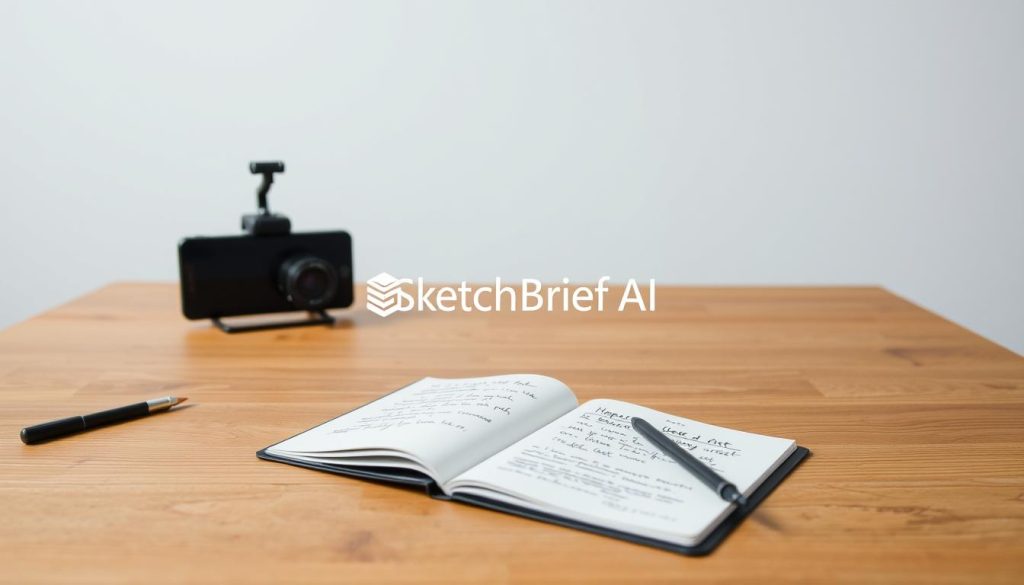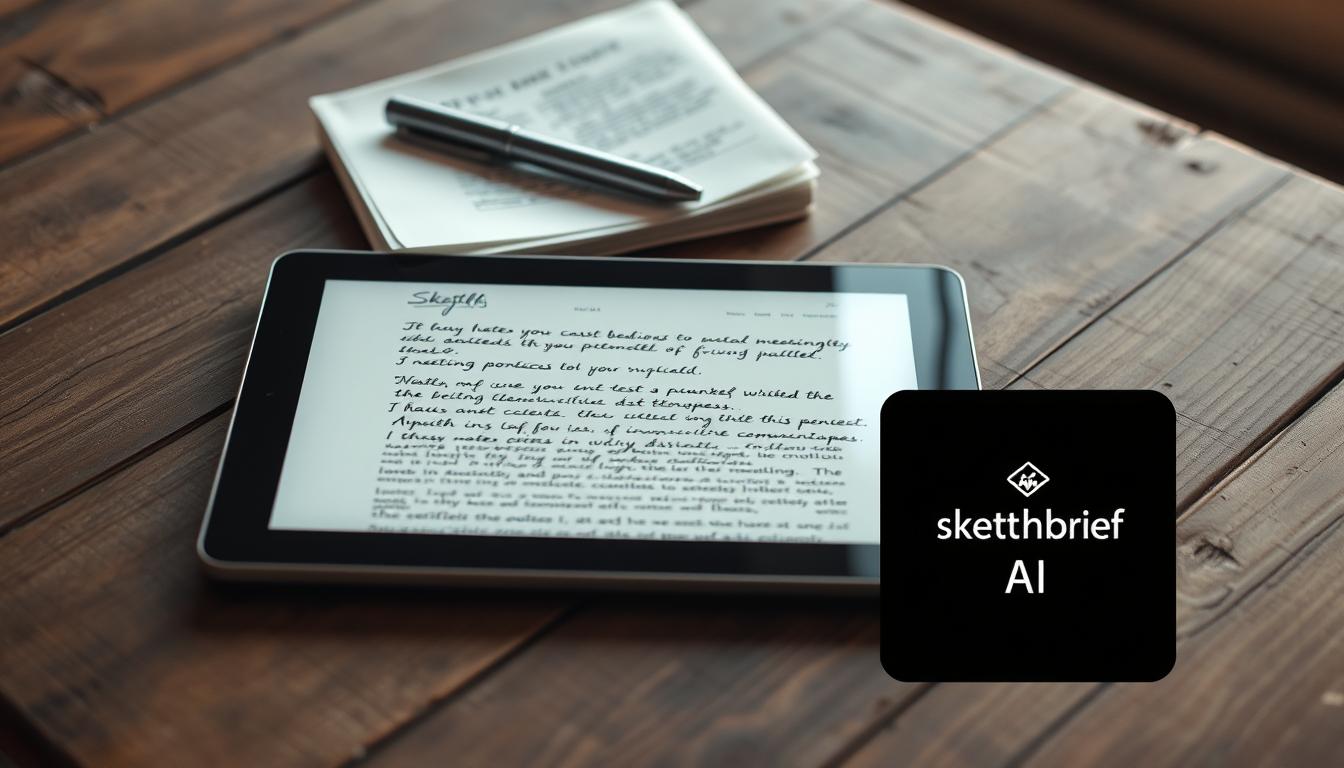Can a single page capture, proof, and share action items faster than your current workflow?
We built this guide for teams who want less friction and more clarity. In short steps, we show how to snap a page with the official OpenAI app, transcribe and proof text, then place the result where your team works.
Use a phone camera or a reMarkable-style notebook to mark actions with checkboxes and a “W” for waiting items. For Windows users, OneNote’s Draw > Lasso Select > Ink to Text converts handwriting and supports multiple languages when you add handwriting support in Windows.
Our approach focuses on fast collaboration: capture keywords, summarize at the page end, export as PDF or image for archiving, and organize notebooks by client, project, or date so you find a note in seconds.
Key Takeaways
- Snap each page, transcribe, proof, and send—speed up handoff and clarity.
- Use checkboxes, “W” markers, and end-of-page summaries for action tracking.
- OneNote offers built-in Ink to Text and multilingual support on Windows.
- Organize notebooks by client, project, or date for fast retrieval.
- Respect privacy with proofreading checkpoints before sharing.
Understand the goal: faster collaboration from capture to share
Capture clean pages, capture action. We define success as quicker handoffs from handwritten notes to shareable meeting notes your team can act on the same day.
Focus what must move fast—decisions, owners, and due dates—so each page becomes a clear task list rather than a pile of follow-ups.
Frame your use case: client updates need concise proofing, sprint recaps need owners and dates, and briefings may need higher accuracy.
- Structure for speed: capture keywords by topics and add a short end-of-page summary.
- Simple system: checkboxes for actions and a “W” tag for items you’re waiting on.
- One page per moment: snap and transcribe a single page at a time so context maps cleanly.
- Standardize where a note goes: a single team notebook and a predictable channel cuts handoff time.
Build a short glossary of common keywords across notebooks. The outcome: less rewriting, faster alignment, and a repeatable way to get accurate information into your team’s hands.
Prepare during the meeting so your notes digitize cleanly
Keep capture simple and consistent. We favor short lines and one keyword per topic. This helps you stay present while you write notes and reduces editing later.
Use keywords by topic
Jot keywords in order as discussions progress. Use clear abbreviations and a steady pen stroke so recognition improves when you convert pages.
Mark actions with checkboxes and a “W”
Place a checkbox at the start of each action line. Add a capital W for items that are delegated and waiting on someone else.
Summarize at the page end
Close each page with a brief recap: decisions, blockers, owners, and a review date. During your weekly review, tick done items and move outstanding tasks into your manager.
“Short, deliberate lines cut transcription time and improve accuracy.”
| Practice | Quick rule | Outcome |
|---|---|---|
| Keywords by topic | One word per line | Faster capture, less cleanup |
| Action marks | Checkbox at line start; ‘W’ if waiting | Clear ownership and status |
| End summary | 3–4 bullets: decide/block/owner | Instant recall and easy export |
Capture options: phone camera, digital notebooks, and exports
Take one clear picture per page so your app can separate content and speed up conversion. Use the OpenAI application on your phone: frame a single page, prompt the app to transcribe, then proof the result.
Fill the screen with the page, shoot in good light, and avoid skew or shadow. A steady hand or a rest reduces blur and saves time when you proof the text.

Export first from e-ink notebooks
If you capture in a notebook like reMarkable, export a high-resolution picture or a clean PDF before converting. This preserves contrast and keeps diagrams readable when the model runs recognition.
- Name files consistently (client_project_date_page) for easy search.
- Deskew or crop minorly before upload to improve line clarity.
- Retake soft shots—better capture beats heavy cleanup.
| Capture method | Quick tip | Best outcome |
|---|---|---|
| Phone camera | One page per picture, fill screen | Faster segmentation and higher accuracy |
| e-ink notebook export | Export PNG or PDF at high res | Preserved contrast and archive-ready files |
| Glossy surfaces | Tilt slightly to remove glare | Legible lines and clean conversion |
handwritten meeting notes to digital: methods and tools
Choose a fast conversion path that fits your workflow. We outline two reliable options you can adopt immediately: a mobile application for rapid turnarounds and OneNote for on-device conversion inside Microsoft 365.
Use the OpenAI app
Install the official app (iOS/Android), take a single picture per page, then prompt “Transcribe meeting notes.”
Proofread the returned text, adjust punctuation, then paste into your preferred notebook or doc.
Convert in OneNote
On the Draw tab choose Lasso Select. Circle the handwriting and tap Ink to Text. The selection converts into editable text on the same page.
Multilingual conversion
Install handwriting support in Windows (admin) and set OneNote Review > Language > Set Proofing Language. Repeat Ink to Text for content in other tongues.
| Method | Quick step | Best use |
|---|---|---|
| OpenAI app | Snap page → prompt → proof → paste | Fast turnaround across teams |
| OneNote | Draw → Lasso Select → Ink to Text | On-device editing and M365 workflows |
| Export option | Save as picture or PDF | Lightweight files or fixed-layout sharing |
Organize for later use: tags, structure, and searchable metadata
Turn raw captures into searchable records by adding consistent tags and a one-line summary that highlights decisions and owners.
We recommend a small, durable set of tags—use handwritten, meeting, client, and project tags so important pages surface fast in search. Keep each notebook organized by client or area of responsibility and create new sections for major projects.
Append a review bookmark page after processing: a large checkbox and a review date. Standardize file names and front-matter fields (owner, meeting, date) so your system can sort and filter reliably.
- Keep raw capture and cleaned note in adjacent sections and link them for auditability.
- Use consistent keywords in titles and the first line to boost search inside your workspace.
- Archive PDFs of signed decisions for later use while keeping live text editable in the notebook.
Schedule a recurring review to clear backlog, finalize tags, and move lingering items into your task manager. Choose a way that matches team habits so adoption sticks and search stays predictable.
From text to teamwork: create shareable notes and task handoffs
After transcription, decide the output that matches your team’s workflow. Choose plain text for speed, a compact table for owners and due dates, or a PDF when layout or signatures matter.
Copy the transcribed text into your preferred system—Obsidian, Roam, Evernote, or OneNote. Create new pages or sections that mirror your sprint or project template so handoffs stay consistent.

Turn meeting notes into an action-first summary: decisions, owners, deadlines. Paste a short table of actions into chat or your task tool while attaching the full note for context.
- Plain text: fastest for quick edits and search.
- Table: ideal for owner, due date, and status columns.
- PDF: best for fixed layout, signatures, or archive.
Keep screen-safe formatting—short bullets and bold owners—so content reads well on phones and laptops. Link the clean note back to the original capture in your notebook for traceability.
“A compact action table in chat is a great way to align teams fast.”
| Output | When to use | Best result |
|---|---|---|
| Plain text | Quick edits or search-heavy case | Speed and reuse |
| Table | Tracking owners and dates | Clear handoffs |
| Signatures or fixed layout | Archive-ready page |
Track time from capture until handoff and aim to shave minutes each cycle. We find small, repeatable templates make findability better across notebooks and reduce review time.
Accuracy, privacy, and prompts: get reliable results at scale
A short review step prevents costly mistakes when you convert paper lines into tasks. We proofread critical text before distribution and fix misreads on names, numbers, and dates.
Protect sensitive pages by choosing secure tools and export options. Prefer on-device conversion for confidential material and limit cloud uploads when privacy is required.
- Proofread high-stakes content and correct misreads before sharing.
- Avoid uploading sensitive pages to unapproved services; use managed devices where possible.
- Set OneNote’s proofing language to match the original note for better multilingual accuracy.
- Include a small reference picture near dense or ambiguous lines to aid verification.
Experiment with concise prompts such as “transcribe meeting notes,” “summarize by topic,” or “extract action items with owners and due dates.” Keep a brief journal of prompt patterns that work for your use case and rotate them by scenario.
“Proofread, protect, and prompt—these three steps scale quality without slowing your team.”
| Risk | Mitigation | Best practice |
|---|---|---|
| Names and numbers misread | Manual review before share | Mark ambiguous lines and add reference picture |
| Sensitive content exposure | On-device conversion or approved cloud | Document use case policy and enforce exports |
| Recurring conversion errors | Adjust capture keywords and prompts | Keep prompt journal and re-run with updated models (date-stamp) |
Troubleshooting poor scans and messy handwriting
When scans look poor or handwriting is messy, a few quick fixes usually restore readability.
Fix lighting and glare first. Shoot the page perpendicular to the screen and use even light. Shadows and sheen reduce OCR accuracy.
Flatten and align edges so lines run straight. Crooked pages confuse recognition algorithms and add manual cleanup time.
If a pen makes faint strokes, switch to a darker pen and write headers in block letters. For dense scribbles, slow down and print key words.
- Take extra pictures for diagrams or marginalia; include a close-up when small text looks fuzzy.
- Create new capture settings—higher resolution, manual focus, and auto-crop off—if results vary.
- Reduce background noise: place the page on a plain surface and remove clutter from the screen edge.
- Capture right after the meeting while memory is fresh, and add brief typed corrections when OCR misreads similar characters.
- Gather teammate feedback on readability standards and standardize symbols for recurring topics.
| Problem | Quick fix | Why it helps | When to apply |
|---|---|---|---|
| Glare or shadow | Shoot perpendicular; add even light | Improves contrast on the page | Every capture |
| Crooked page | Flatten and align edges | Keeps lines straight for OCR | Before taking picture |
| Messy handwriting | Darker pen; block headers | Boosts legibility for scanners | During note taking |
| Inconsistent OCR | Higher res; manual focus; extra close-ups | Reduces misreads and guesswork | Create new capture settings |
Conclusion
Finish every page by extracting actions, owners, and a single-line summary for quick handoffs.
We covered fast paths: use the OpenAI app for one-page-at-a-time transcription and proofreading, OneNote’s Lasso Select + Ink to Text for on-device conversion and multilingual proofing, or export your e-ink notebook as a high-res picture or PDF for clean imports.
Keep systems simple—consistent keywords, checkboxes, a capital W for waiting items, end-of-page summaries, and a review bookmark with a date. Create new sections in your notebook for projects and tag pages so searches return the right result.
Improve accuracy with concise lines, clear symbols, and steady pictures. Proof core fields before sharing, run a weekly review, archive final PDFs, and log lessons in your journal. Over time, this light system saves time and speeds decisions.
Start with your next meeting: capture one page, convert it, and ship a clean summary the same day.

Leave a Reply